
| Publisher: | Gallery | |
| Genre: | Women, Family Life, General, Romance, Contemporary, Fiction | |
| ISBN: | 9781501179129 | |
| Pub Date: | March 2019 | |
| Price: | $26 |
| Fiction |
by Lolly Winston
Rudy and Bethany have an enviable life. Married since college, they're still best friends, savoring their near-retirement years even after Rudy was laid off. Bethany still has her job; Rudy enjoys his part-time gig at Nordstrom's playing baby grand piano; and their daughter, CeCe, is successful and happily married. But one morning, Rudy awakens and romantically whispers a suggestion that they go to the beach, only to realize that Bethany isn't breathing. And just like that, Rudy is a widower.
Lolly Winston (Good Grief; Happiness Sold Separately) has a knack for finding the joy after heartbreak, and in Me for You she writes a hopeful but realistic plot. Rudy is lonely (an "embarrassing thing to speak of," which "implied that you personally were deficient") but not keen on following CeCe's encouragement to enroll in the community college online dating class. He instead imagines cooking dinner for Sasha, the Hungarian salesclerk working near his piano, and they do form a friendship. Rudy is happy to advise Sasha on her troubles--an alcoholic husband who's abandoned her and their debts, plus her own recent tragedy--but his grief over losing Bethany only worsens. When CeCe finds he's unkempt, skipping work and despondent, she arranges for a hospitalized rest, and his Stanford doctors diagnose major depressive disorder.
Through Rudy's hospitalization and recovery, Winston writes knowingly of mental health and its treatment. Me for You is a romance with a core of compassion for the struggles following the loss of a loved one, and Rudy's happy ending is well-earned. --Cheryl Krocker McKeon, manager, Book Passage, San Francisco
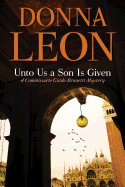
| Publisher: | Atlantic Monthly Press | |
| Genre: | Mystery & Detective, General, International Crime & Mystery, Literary, Fiction | |
| ISBN: | 9780802129116 | |
| Pub Date: | March 2019 | |
| Price: | $26 |
| Mystery & Thriller |
by Donna Leon
In Unto Us a Son Is Given, her 28th Commissario Guido Brunetti mystery, Donna Leon begins with her trademark gentle style. Brunetti's father-in-law, Count Orazio Falier, approaches the commissario about meeting with an elderly friend. Gonzalo Rodriguez de Tejada, the godfather of Brunetti's wife, Paola, wishes to adopt a young man because, according to Italian inheritance laws, the childless, single Gonzalo's estate will be divided among his siblings, whom he despises. Gonzalo is gay, enamored with a suave man much younger than he is, and this man is his proposed candidate for adoption. Count Falier and all of Gonzalo's other friends are appalled; Gonzalo resents their interference.
Brunetti tiptoes around the situation, hesitant to deny his father-in-law, but also abhorring the thought of interfering in the life of his wife's godfather. When Gonzalo unexpectedly drops dead, Brunetti thinks the quasi-case is closed, until a close friend of Gonzalo is murdered.
There is a gentle pace to how Brunetti and the indomitable Signorina Elettra, the Venice Questore's resident computer wizard, discreetly delve into the history of the Falier and Rodriguez de Tejada families. Unto Us a Son Is Given takes a familiar detective and his wife and adds intriguing layers to their backstory. Fans of other quiet mystery authors, like Louise Penny or Jacqueline Winspear, are sure to enjoy Brunetti's soul-searching. And, as always, Brunetti's introspection is framed by the sights and tastes of Venice, which Leon brings to life. --Jessica Howard, bookseller at Bookmans, Tucson, Ariz.

| Publisher: | Putnam | |
| Genre: | Psychological, Family Life, General, Suspense, Thrillers, Fiction | |
| ISBN: | 9780525538141 | |
| Pub Date: | March 2019 | |
| Price: | $26 |
| Mystery & Thriller |
by J.P. Pomare
From the title of J.P. Pomare's first novel, Call Me Evie, readers can guess Evie isn't the real name of the 17-year-old protagonist. But Pomare makes it hard to ascertain exactly what's going on with her, with her loss of memory and limited view of the world.
She's involved in something traumatic that happened recently in her hometown of Melbourne, but she can't remember it. A man she calls her uncle Jim has taken her to New Zealand and mostly locked her up in a house, away from the Internet and neighbors' prying eyes, in a supposed attempt to help her recall details of the night in question. He forces her to take pills and says she can't go back to Australia until she remembers; she needs control of the facts when police question her. The situation gains urgency when the incident back home is labeled a murder, and Evie's fragmented memories make her question everything Jim says and where the threat is actually coming from.
Pomare grabs readers by the throat the way Jim grabs Evie by the hair in the opening scene, when she tries to escape the house. Everything Jim does he claims is to protect her, and sometimes he seems genuine about that. The author maintains this sense of uncertainty and dread throughout, as Evie--along with the reader--puts together the pieces of her memory. Because she trusts no one, everyone is suspect, including herself, up until the satisfying conclusion. --Elyse Dinh-McCrillis, blogger at Pop Culture Nerd

| Publisher: | Feminist Press | |
| Genre: | Short Stories (single author), Humorous, Absurdist, Apocalyptic & Post-Apocalyptic, Fiction, Science Fiction | |
| ISBN: | 9781936932481 | |
| Pub Date: | March 2019 | |
| Price: | $16.95 |
| Science Fiction & Fantasy |
by Asja Bakić, trans. by Jennifer Zoble
Bosnian writer Asja Bakić revels in the surreal. The plots and settings of the stories collected in Mars might get labeled as science fiction or dystopian, but the works themselves feel weightless, unmoored to any real convention as they probe dark corners of the human psyche. There are clones, trips to distant planets, even zombies, but far more memorable are the moments charged with meaning that so often end Bakić's stories, where a look, a touch or a word can upend the world.
The best of the stories in this debut have endings that lie somewhere between twists and epiphanies. In "Buried Treasure," an imaginary monster discussed by a group of children turns out to be real, though neither they nor their parents realize that it is living peacefully among them. In "Carnivore," a man attempts to cheat on his wife with a stranger, only to find that the woman is in fact his wife's mistress; furthermore, his spouse is tied up in the closet of the woman's apartment. But Bakić doesn't play these revelations for thrills, instead using them to break the reality of the little worlds she's constructed, pulling the rug out from under her readers to induce a kind of literary vertigo.
Tricky and hard to pin down, these stories tease and perplex. Readers who might not be interested by zombies and interplanetary space flight shouldn't discount this book. Likewise, lovers of science fiction and horror will find a wonderfully surreal take on tried-and-true stories, where the strictures of plot break open to release something stranger and darker. --Noah Cruickshank, director of communications, Forefront, Chicago, Ill.

| Publisher: | Grove Press | |
| Genre: | Biography & Autobiography, Discrimination & Racism, Personal Memoirs, Political, Penology, Social Science, Cultural, Ethnic & Regional, African American & Black, Criminology | |
| ISBN: | 9780802129086 | |
| Pub Date: | March 2019 | |
| Price: | $26 |
| Starred | Biography & Memoir |
by Albert Woodfox
Activist Albert Woodfox does not profess to be a saint in his memoir Solitary. He's painfully honest with his audience, detailing the path that led him to a 50-year prison sentence in Angola in the 1970s. Woodfox also unlocks the bars and ushers his readers into conditions most would consider beyond their darkest nightmares: "Coming out of slavery and convict leasing, it was as if the cruelty of Angola's history leaked into our present world. Angola was run like an antebellum slave plantation."
Despite the barbaric environment, Woodfox finds hope and purpose in the principles of the Black Panther Party. He explains, "I didn't just get it with my mind, I felt it with my heart, my soul, my body. It was as if a light went on in a room inside me that I hadn't know existed." His involvement with the group turns into a mixed blessing, though. He and another member are framed for a guard's murder and receive life sentences in solitary. Kept in a 6'x9' cell for 23 hours a day, it's the Panther code of living that helps Woodfox ultimately maintain his humanity until he's exonerated nearly 45 years later.
In beautifully poetic language that starkly contrasts the world he's describing, Woodfox awes and inspires. He illustrates the power of the human spirit, while illuminating the dire need for prison reform in the United States. Solitary is a brilliant blend of passion, terror and hope that everyone needs to experience. --Jen Forbus
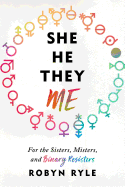
| Publisher: | Sourcebooks | |
| Genre: | Personal & Practical Guides, Reference, Gender Studies, General, Social Science, LGBT Studies | |
| ISBN: | 9781492666943 | |
| Pub Date: | March 2019 | |
| Price: | $22.99 |
| Social Science |
by Robyn Ryle
You've been born an alyha among the Mohave at the turn of the 20th century, and are neither man nor woman. Or: you're born a cisgender male in a patriarchal society. Or maybe you were born with an intersex condition. But you could also be a transgender Asian American woman who gets married, a working-class gender-expansive pansexual person or a white gay man with a disability.
How can these realities possibly be contained in a single experience? When organized into a fun, thoughtful and instructive "choose your own adventure"-style book!
In She He They Me, sociologist Robyn Ryle guides readers through more than a hundred different scenarios that show how gender and sex intersect with culture, race, class and disability. Readers can work their way through nearly endless permutations, "trying on" various identities and exploring how cultural contexts might interact with those identities.
The book's playful, non-linear, experimental form deliberately echoes the idea that gender can also be playful, non-linear and experimental. In the introduction, Ryle writes that one reason she wrote this book is because "seeing the world in new and different ways can be a little scary. But eventually, it's liberating and exciting... I wanted to share that scary and exciting adventure with people everywhere."
Those who view gender as binary, fixed and inherently tied to certain biological and cultural behaviors may find She He They Me surprising or uncomfortable, but that's why they should read it. If nothing else, it's an exercise in empathy--and only good can come from that. --Hannah Calkins, writer and editor in Washington, D.C.
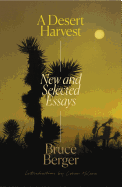
| Publisher: | Farrar, Straus and Giroux | |
| Genre: | Nature, Ecosystems & Habitats, Environmental Conservation & Protection, General, Deserts, Literary Collections, Essays | |
| ISBN: | 9780374220570 | |
| Pub Date: | March 2019 | |
| Price: | $26 |
| Starred | Essays & Criticism |
by Bruce Berger
Bruce Berger (Facing the Music) grew up in suburban Chicago, but the desert of the American Southwest is the place he calls home. In his gorgeous essay collection, A Desert Harvest, Berger paints a portrait of a place that's much stranger and more beautiful than most popular presentations would suggest. "Despite cartoons," he writes in "The Mysterious Brotherhood," the desert isn't riddled with "melodramatic bones." Instead it offers "quieter revelations of the vegetable world." He goes on to describe the elusive loveliness of different varieties of cacti at various stages of decay. The intricate patterning of the prickly pear's internal leaves, readers learn, discloses itself only in death.
The subject of death appears again in the collection, most notably in "Comfort That Does Not Comprehend," in which he describes the aftermath of his mother's passing. She had been living in a home in the Arizona desert, having made the move from Chicago when her husband was still alive. Berger draws heartbreaking parallels between the loss of his mother and the loss of several desert acres that succumbed to fire.
The collection isn't all macabre, however. "Cactus Pete" introduces the eccentric titular character, an elderly man who claims to have learned how to map the surfaces of other planets with a handmade "gizmo." The essay is part character study, part celebration of the founding of the small desert town Pete lives in. Moving and enthralling, A Desert Harvest proves that wonder and beauty can be found in even the most desolate places. --Amy Brady, freelance writer and editor

| Publisher: | HarperOne | |
| Genre: | Personal Growth, Biography & Autobiography, Spirituality, Christian Living, Devotional, Religion, Comparative Religion, General | |
| ISBN: | 9780062406569 | |
| Pub Date: | March 2019 | |
| Price: | $25.99 |
| Religion |
by Barbara Brown Taylor
As an Episcopal priest, Barbara Brown Taylor (Leaving Church) spent years delving into the nuances of Western Protestantism. But after parting from parish ministry, she found herself ever more curious about--even envious of--certain elements of other faiths. She began teaching Religion 101 to undergraduates at Piedmont College in rural Georgia, which gave her the chance to explore along with her students. It was permission to learn the basic tenets of five major world religions, as well as to walk forward into the wonder and joy that might await them in a temple, a synagogue or a mosque. In Holy Envy, her 14th nonfiction book, Taylor chronicles two decades of exploration and struggle, as she took her students on field trips to new places and unfamiliar spiritual terrain.
In a time when religious differences are often the subject of polarizing arguments, Taylor offers another way: a gentle, holy curiosity laced with compassion and wonder. She urges her readers to ask questions, to stay open to encountering the divine in whatever form it may appear. Most of all, she encourages keeping a loose grip on certainty: "Once you have given up knowing who is right, it is easy to see neighbors everywhere you look." If this is heresy, it is the most joyful and thoughtful kind: a call to see all people, of all faiths or none, as fully human, and to accept that the divine may show up in ways we least expect. --Katie Noah Gibson, blogger at Cakes, Tea and Dreams
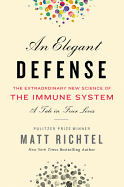
| Publisher: | Morrow | |
| Genre: | Life Sciences, Immunology, Health & Fitness, Science, Biology, Medical, History, Immune & Autoimmune, Diseases | |
| ISBN: | 9780062698537 | |
| Pub Date: | March 2019 | |
| Price: | $28.99 |
| Science |
by Matt Richtel
In An Elegant Defense: The Extraordinary New Science of the Immune System, Pulitzer Prize-winning journalist Matt Richtel takes the reader on a remarkable journey of exploration inside the human body. His focus is that most crucial connection to every aspect of a person's health and wellness, the immune system.
Richtel's (A Deadly Wandering) approach is richly informative and engaging, a distinctive analysis of life's essential attributes. Just as the immune system works as a peacekeeping force through cooperation with bacteria inside and outside the body, he explains, so should mankind seek cooperation with nature and global neighbors to topple cancer, Alzheimer's and autoimmune diseases. Working to promote balance and harmony inside the body, the immune system functions best without too much tinkering or unnatural interventions. And so, Richtel suggests, gentle, natural remedies are more desirable than aggressive medical interference.
Of course, it's not always possible to avoid toxic drugs and their side effects, especially when fighting cancer, AIDS or other autoimmune diseases. Through the remarkable case histories of four individuals, Richtel explains the ways in which the immune system plays an intricate game of defense and how easily things go wrong when it gets out of control. Richtel's best piece of advice is to stop trying to live forever because this "festival of life" wasn't designed to last indefinitely. Instead we should focus our energies on things we can control, like sleep, exercise, meditation and nutrition. Eminently readable and with so many important takeaways, An Elegant Defense is well worth one's investment of time. --Shahina Piyarali, writer and reviewer

| Publisher: | Crown | |
| Genre: | Biography & Autobiography, Women, Travel, Europe, Italy, Essays & Travelogues | |
| ISBN: | 9780451497697 | |
| Pub Date: | March 2019 | |
| Price: | $27 |
| Travel Literature |
by Frances Mayes
The name Frances Mayes has become synonymous with Italy. For the past 30 years, she's split her time between a home in the United States and one in Tuscany. Mayes captivated readers with her blockbusters Under the Tuscan Sun and Women in Sunlight, stories of how Italy--the culture, the landscape and the Italian way of life--has the power to change and transform people. In See You in the Piazza--part guidebook, part travelogue--Mayes's passion for Italy is further enlarged when she and her husband, Ed, hit the road in their Alfa Romeo. The pair--along with cameos by their grandson and friends-- explore the many charms of Italy, uncovering secret places only the locals know, from the northern Piemonte region south to Sicilia.
Rich, sensory descriptions are hallmarks of Mayes's work. Whether on or off the beaten path, Mayes's writing--about hiking or marketing, sightseeing or lounging with books by a pool--offers an intimate, stream-of-conscious perspective on discovering unexpected treasures. Traveling to 13 regions over a year and a half, Mayes offers a trove of little-known information about wine, food and cooking, out-of-the-way restaurants, history, quirky museums and architecture, religious and literary influences. Mouth-watering regional recipes cap off each chapter.
Italophiles, fans of Mayes and armchair travelers will be more than eager to set off on an adventurous journey that provides a rare glimpse into "unique places hidden in plain sight"--the very best of what Italy has to offer. --Kathleen Gerard, blogger at Reading Between the Lines

| Publisher: | Candlewick | |
| Genre: | Biography & Autobiography, Computers, Women, Coding & Programming, Juvenile Nonfiction, Science & Technology | |
| ISBN: | 9780763693565 | |
| Pub Date: | March 2019 | |
| Price: | $19.99 |
| Starred | Children's & Young Adult |
by Emily Arnold McCully
Two centuries before computers became ubiquitous, a brilliant young British woman named Ada Lovelace imagined an "engine" that could process information much like today's computers do. The life of this forward-thinking scientist is brought to light for young readers in Emily Arnold McCully's fascinating biography Dreaming in Code.
Dreaming in Code progresses chronologically from Lovelace's birth in late 1815 (to a domineering mother and poet Lord Byron, the "titled, handsome, reckless, and irresistible" father whom she never knew) to her painful death from cancer in 1852. Although her controlling mother stinted on emotional nurturing, she did give Lovelace a far more rigorous education than most girls of her time were allowed. As a young adult, Lovelace cultivated mentors, one of whom was Charles Babbage, a quirky inventor, scientist and mathematician whom she met when she was 17 and he was 41. During their two-decades-long collaborative friendship, Babbage was developing and modifying engines designed to replace mental labor. Lovelace understood the workings of these machines in a way no one else did, even Babbage himself.
McCully is the Caldecott Medal-winning author/illustrator of Mirette on the High Wire as well as dozens of other children's books, such as Clara. Dreaming in Code is written with grace and intelligence, researched with care and peppered with historic photos and remarkable illustrations of 19th-century technology. It's sure to inspire a new generation of pioneers unwilling to let obstacles distract them from leading the way into the future. --Emilie Coulter, freelance writer and editor

| Publisher: | Tilbury House | |
| Genre: | Biography & Autobiography, Law & Crime, United States - 20th Century, Presidents & First Families (U.S.), History, Juvenile Nonfiction, Historical | |
| ISBN: | 9780884486206 | |
| Pub Date: | March 2019 | |
| Price: | $17.95 |
| Children's & Young Adult |
by Michael Garland
Legend claims that in 1941, Franklin Delano Roosevelt rode to the Capitol Building to deliver his "Day of Infamy" speech in Al Capone's bulletproof Cadillac--"ten years after the gangster climbed out of this automobile for the last time, one of America's greatest presidents climbed in." Using this yarn as the basis of his beguiling picture book, Michael Garland (Birds Make Nests; Fish Had a Wish) tells parallel stories, comparing the life of beloved U.S. president Franklin Roosevelt to that of notorious mobster Al Capone.
Both Roosevelt and Capone regularly appeared in headlines during the early 20th century; as Roosevelt ascended in politics, Capone rose in the ranks of the nation's crime syndicate. Garland further connects them by explaining that "both were smart and ambitious" and "young when their fathers died." Through such comparisons, he reels in readers and feeds them wonderful tidbits of biographical information about each man: Roosevelt's mother "kept his hair long and dressed him in frilly gowns"; Capone earned his Scarface nickname when he "received a knife wound to his cheek during a fight." The two may have even "passed each other in the streets of New York. But... headed in opposite directions."
As the audience peeks into the lives of both men, they're treated to Garland's bold and richly textured digi-woodcut illustrations--digital art that mimics woodcut--which give the book an antique feel and lend a sense of gravity to the overall design. Following Garland's comparison of Roosevelt and Capone, he offers resources for further reading as well as a more detailed timeline of their lives, which many are sure to pursue after the enticement of this striking picture book. --Jen Forbus, freelancer
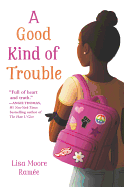
| Publisher: | Balzer + Bray | |
| Genre: | People & Places, School & Education, United States - African-American, Social Themes, General (see also headings under Family), Juvenile Fiction | |
| ISBN: | 9780062836687 | |
| Pub Date: | March 2019 | |
| Price: | $16.99 |
| Children's & Young Adult |
by Lisa Moore Ramée
Lisa Moore Ramée's debut middle-grade novel, A Good Kind of Trouble, features junior high school student Shayla Willows, a black girl figuring out shifting friendships, social justice issues and a newly found love for running track.
Shayla and her two best friends, Isabella, a Puerto Rican artist, and Julia, a Japanese-American basketball player, call themselves the United Nations--they've been friends "since forever" and inseparable "super best friends since third grade." But junior high threatens to split up their alliance: now that she is without braces or unibrow, Isabella's outer beauty has caught up with her inner, and, according to her Instagram account, Julia is "squad goals" with the other girls on her all Asian-American basketball team. Even as she creates new friendships, Shayla will have to confront her envy if she wants to keep the United Nations together. At the same time, a police officer is on very public trial for shooting an unarmed black man, forcing Shayla to understand how prejudice affirms ignorance and hate. Perhaps it's time for Shayla to get into a bit of trouble of her own.
Ramée's narrative is straightforward and relevant for a contemporary middle-grade readership, showcasing friendship, community and the diversity of experiences that exist within different marginalized groups. The story moves swiftly and skillfully through a year of Shayla's maturation as an athlete, a sister and a friend. Putting an extra fine point on the depth of Shayla's growth, each chapter ends with direct entries from her observation journal, often poignant musings such as, "I... don't get why some people would think black people are against them when we're the ones getting shot." These and other emotional insights mark the questions of Shayla's (and our) present and future. --Breanna J. McDaniel, freelance reviewer